1980 Argentinian Grand Prix race report
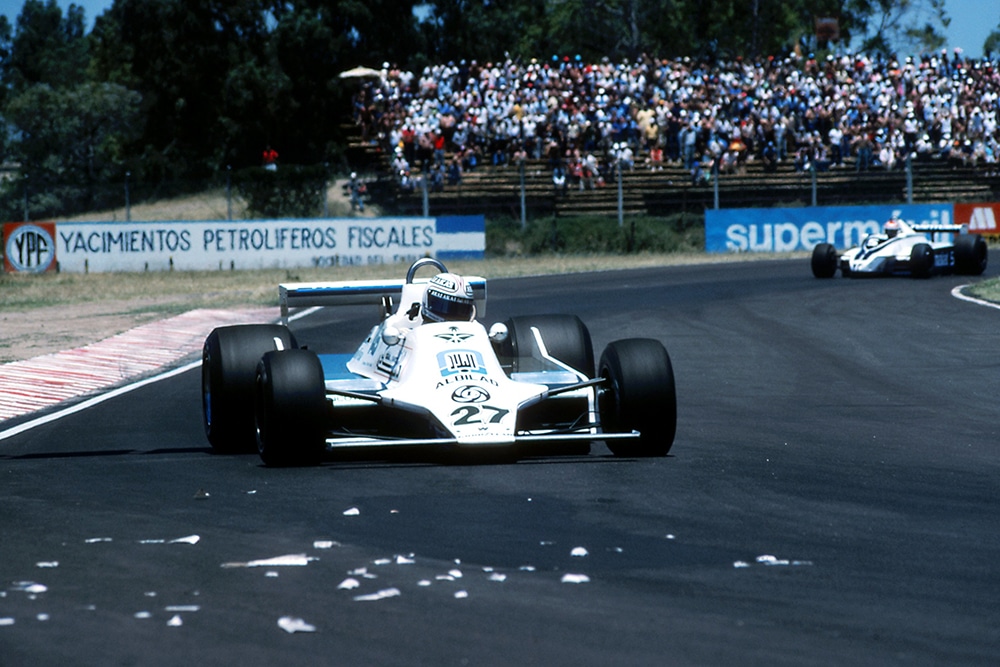
Alan Jones took victory at the season opener in his Williams FW07.
Motorsport Images
A good start
Buenos Aires, January 13th
With Christmas and the New Year over the Formula One scene was soon in full swing and air freighters-were taking the cars to South America for the first of the 1980 races, with the drivers and team personnel soon following, clutching their Enteroviaform and Ambre Solaire, for the Argentinian food and summer, respectively. As the 1979 season ended there were some indecisions about who joined which team, but everything was eventually sorted out and while the businessmen shuffled their paper-work and talked money the designers drew new cars or modified the old ones and the workers applied themselves to the tools of their trades and made the new cars or rebuilt the old ones. Strikes, absenteeism, industrial strife and unrest are things unknown in the world of motor racing, everyone gets stuck in and an impressive collection of machinery was assembled in the Buenos Aires Autodrome to start practice.
There was some slight reshuffling of racing numbers, with Ferrari taking 1 and 2, for World Champion Jody Scheckter and his eager team-mate Gilles Villeneuve, both having new T5 Ferraris to race. Lotus dropped from the head of the list to take the old Ferrari numbers of 11 and 12, with Mario Andretti leading the team. After a certain amount of legal hoo-ha the young Italian Elio de Angelis bought himself out of his contract with the Shadow team and joined Lotus as number two. After the disastrous 1979 season when the promising new Lotus 80 failed to work properly and the team seemed to forget how to make the Lotus 79 work, the winter break allowed them to come up with the Lotus 81, which can best be described as a cross between the last two models. Last year Carlos Reutemann started the season well with Team Lotus, but gradually became disenchanted with the situation, as they did with him, and he left the team at the end of the year to eventually join the Williams team as number 2 to Alan Jones, the aim being to have the Williams cars in a strong 1-2 position at all times. There did not appear to be any necessity to drop the successful FW07 design and Patrick Head’s winter work involved designing a B-version which incorporated all the detail improvements that were experimented with and thought up during 1979. Little of the original cars is being used to form the basis of the B-version though no radical changes were made to the basic design.
Regazzoni did not linger around the Williams team once he knew that Reutemann was being sought, and he joined the Ensign team which was being re-constituted and financially backed by Unipart. A lot of overtime by Morris Nunn’s team got their new design finished in time for a brief run before being flown out to South America where it made its debut in red, white and blue colours.

Nelson Piquet put his Brabham 4th on the grid
© Motorsport Images
The Tyrrell team lost their promising young Frenchman Didier Pironi to the Ligier team, but were not too worried as they were signing on the Irishman Derek Daly who had shown good promise last year. Having blatantly copied the Lotus 79 to build the Tyrrell 009, the next step was a problem, for the Lotus 80 was not a design to copy and to step sideways and build a Williams-copy was not practical, so the 009 series cars were altered and modified in the light of 1979 experience, but the light was not very strong. Jean-Pierre Jarier, who has promised so much and achieved so little, retained his place in the team. The space in the Ligier team for Pironi was provided by the departure of Patrick Depailler, who could not see much future as “joint number one” with Jacques Laffite and left to join the Alfa Romeo team with young Bruno Giacomelli as his partner. At the end of the 1978 season the way ahead for aspiring designers was simple, for Colin Chapman had proven the “ground-effects” principle and it was a simple matter to follow it, and the Ligier team were one of the most successful. When the Williams FW07 proved to be more effective than most it was not easy to see why, so that teams that lacked an original thinker on the design staff were unsure of their next move and could only uprate their 1979 cars as best they could, the Ligier cars for Argentina being modified JS11 models, heading towards the next completely new design, the JS15. McLaren found themselves in a similar situation and altered the M29 design where they could, to produce the M29B. John Watson retained his position as team leader, but Patrick Tambay was replaced by Alain Prost, the 1979 European F3 champion. This was unfortunate for Tambay, who seems to be a driver who needs a good leader. When James Hunt was leading the McLaren team, Tambay showed good promise in his style and ability to match the pace of his leader, but last year with Watson at the front there was little to inspire Tambay and he faded away.
The Renault team spent the short winter break with no problems, the RS10 to RS14 twin-turbo-charged cars were taken apart to form the basis for a new set of cars incorporating a great number of detail changes, but no radical departure from the basic design. There were no driver problems, for like the Ferrari team, the drivers liked the team and the team liked the drivers, so Jabouille and Arnoux stayed with the turbo-charged 1 1/2-litres.
As already reported the Fittipaldi team bought the assets of the Wolf team, including the cars, designers, management and driver and the newly constituted Fittipaldi team, no longer backed by Copersucar, doubled its size overnight. The basis of the WR Wolf cars formed the new Fittipaldi F7, as an interim design to get Emerson Fittipaldi and Keijo Rosberg to this first race. The constitution of the Arrows team was unchanged over the winter, but a simpler car was built, known as the A3, utilising some of the good points of the unusual and unsuccessful A2 design. Drivers Patrese and Mass retained their positions in the team. The two back-markers from last year, ATS and Shadow, just scraped onto the FOCA list of members, the German-financed team expanding to run two cars, for Marc Surer and Jan Lammers, and the Shadow team regrouping itself with a new design, the DN11, and with drivers David Kennedy, the forceful Irishman from Aurora racing, and Swedish F3 driver Stefan Johansson.
Last, but by no means least, the Ecclestone team of Brabham cars were as seen at the end of last season. With Alfa Romeo running their own cars there was little future in using the Alfa Romeo engines so Ecclestone made an instant and complete break and returned to the Cosworth fold, and concurrently Niki Lauda gave up racing and disappeared from the scene. In a situation that would have destroyed some teams, Ecclestone’s Brabham team burst through with a new lease of life. Gordon Murray designed the BT49, using Cosworth DFV power and it was very competitive from the word go, while Nelson Piquet’s undoubted ability was given a free rein as he took over the number one position in the team. He was joined by Ricardo Zunino, from Argentina, who showed good promise from the word go.
Everyone had arrived early, thanks to the efficient transport organisation of the FOCA and there was an unofficial test-session on the Thursday before official practice began on Friday morning. During this three-hour session there were three major factors that arose, firstly the Goodyear Racing Division told everyone loud and clear that there were no special, super-sticky, soft qualifying tyres for ANYONE. As far as Goodyear are concerned qualifying tyres are finished. They found it a wasteful and expensive avenue of development that did not teach them anything and had tried to get the FISA and FOCA organisations to do something about eliminating them. Michelin were agreed in principle that qualifying tyres were best abandoned, but nobody did anything so Goodyear’s Leo Mehl took the initiative and stopped any further production of special short-life qualifying tyres. There were three types of tyre available for the Goodyear runners, all of which would go the race distance, but with varying degrees of hardness to cater for different cars and drivers. This was a hard and ruthless decision, but it was necessary in the face of the lethargy of the FISA and FOCA and generally speaking it was applauded by everyone. The feeling is that Michelin will be “shamed” into following suit. Goodyear also made it clear that if their decision was unpopular they might be forced to fade quietly away from Formula One.
The second thing that came to light on Thursday was the fact that parts of the track had been resurfaced too recently and the heat and the tyre adhesion of today’s car was tearing the surface to pieces, as happened in Zolder in 1973. While one faction was talking about not racing, led by a rather vociferous Jody Scheckter in his new role as President of the re-formed GPDA, another group led by Alan Jones was saying “We’ve come, we’re committed, we’ll have to get on with it as best as we can, but in all honesty there shouldn’t be a race on the track as it is.” Scheckter was also busy trying to whip up support for boycotting the forthcoming race at Interlagos in Brazil, in view of the roughness of the track. The Brazilian race was due to be held at the new Rio de Janiero circuit, but at the last minute it was discovered that that track was sinking into the sand-bed on which it was built so a hurried switch back to Interlagos was made.
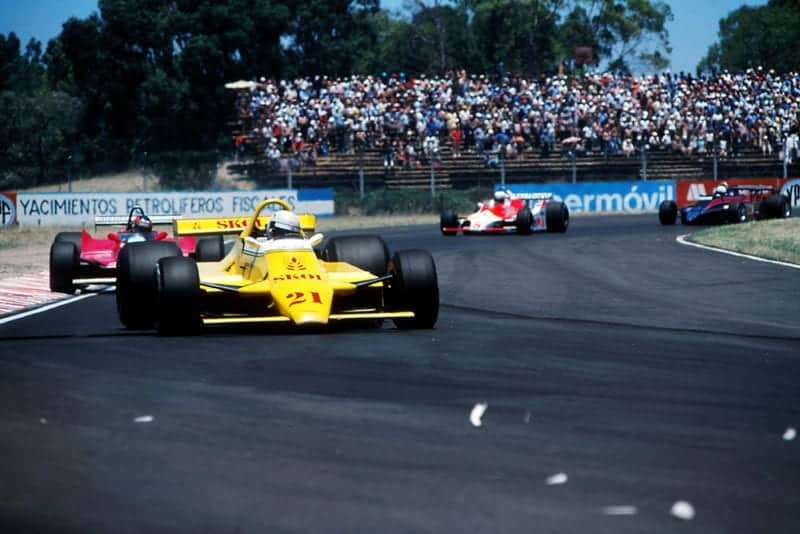
Keke Rosberg started 13th in his first race for Fittipaldi
© Motorsport Images
Advancement in chassis technology is one of the factors in this bumpy circuit problem, for with increased down-force of 400-500 lb being gained from aerodynamic studies, suspension spring-rates have had to be doubled or even trebled in order to retain control of suspension movements so that a bump of two years ago that could be ridden over with a soft spring, has now become a major obstacle that bounces the car into the air rather than making the suspension work. If softer springs are used the good cars will bottom-out at high speed. It is an engineering problem more than a surface problem, but some drivers cannot see this and blame the surface.
The third thing was the decision to stagger the two-by-two grid, as has been done in Monaco in recent years, to form a one-by-one line of cars for the start, offset alternately. The result of this decision meant that practice times and grid positions were more important than ever. for second fastest would no longer put you on the front row, you would be some 10 yards behind the pole-position car. Drivers at the back of the 24-car grid were going to need very good eyesight to see the green light!
Qualifying
Apart from these three major factors arising before practice began there were personal troubles as well, especially in the Williams team for Alan Jones had found the old FW07/4 to be much better in terms of speed, balance, and adhesion than the B-series car, with its different rear suspension and different aerodynamics. Friday practice saw more tests carried out and that night the decision was made to convert both B-series cars back to 1979 specification as far as was possible, and this meant a lot of all-night work, ending at 3 a.m. Saturday morning and starting again at 6 am! Racing mechanics really earn their money. Jones used the T-car to make fastest time on Friday afternoon and Saturday afternoon while Reutemann was troubled by ignition trouble and only did a few laps. By the time his car was rebuilt the track surface had deteriorated so badly that he had little chance of recording a good time. Despite this trouble, in his home Grand Prix with a new team, he seemed relaxed and content; disappointed, perhaps, but much more philosophical than expected.
The Ligier team were fairly happy. Laffite making second fastest time on Friday, which was just as well as his car had to have a last-minute engine change before the final session on Saturday, due to a persistent oil leak, and then he had trouble with the fuel pressure so that he only managed one lap on Saturday afternoon and that took him 13 min. 02.48 sec., an average of 27.45 k.p.h., Whether this jaundiced his view or not, he was one of the vociferous ones wanting to have the race cancelled due to the deteriorating surface, which was a measure of how serious the situation had become, for he is normally pretty even tempered. Pironi was very happy with his new team and new car and when asked if it was better than the Tyrrell 009 he remarked that it had “better brakes, better steering, better handling, better traction . . .”. Clearly better!
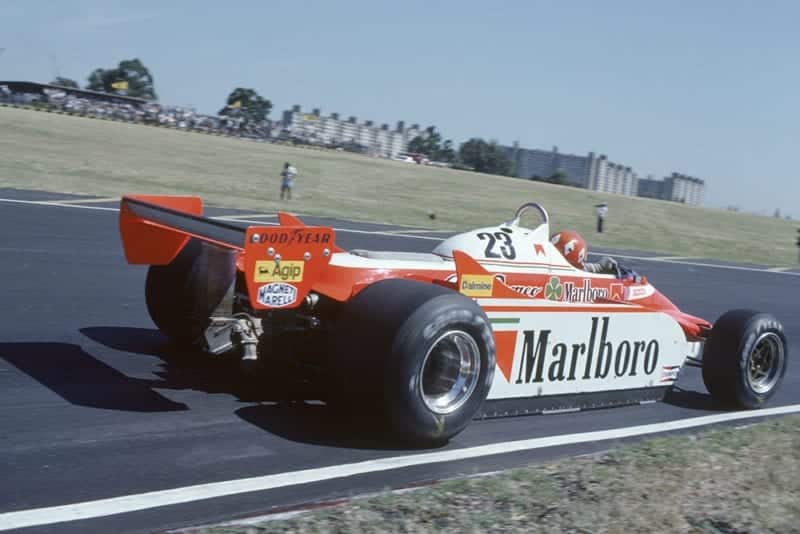
Bruno Giacomelli could only qualify his Alfa Romeo 20th
Motorsport Images
The Brabham team were not as happy as they felt they ought to be for Piquet, who is as brave as they come, was feeling a bit un-nerved by his cars’ inability through the very high speed corners. and could not match the times of the front runners. In the untimed session on Saturday morning he was out in the T-car, trying softer front springs when he had a high-speed spin and crashed backwards, through the catch-fencing on the left-right before the pits hairpin. Earlier Rosberg had done the same thing in the spare Fittipaldi car, but luckily, it had been moved before Piquet arrived on the scene. The Brabham was extensively damaged about the rear end so in the final timed session, both team drivers had to be a bit cautious, knowing there was no spare car available. Even so, Piquet managed a courageous 1 min. 45.02 sec., which put him into fourth place. Zunino was content to qualify in sixteenth place with 1 min. 47.41 sec.
In the Lotus camp there was a great deal of optimism by the end of practice, even though de Angelis had made a dramatic start to his career with Team Lotus by having a major spin, followed by a high-speed trip backwards into the catch-fencing during Thursday’s test-session. The Lotus lads had a lot of work to do repairing the damage, but the young Italian made up for it by eventually turning a lap in 1 mm. 45.46 sec. which gave him fifth place on the grid, one place ahead of his team-leader. Andretti was not dismayed for the Lotus 81 was feeling very muck to his liking, particularly with a full fuel tank, and he could have gone faster than the 1 min. 45.78. sec, he recorded on Friday, had trouble not intervened in the final practice session. He was just getting into the groove when he suffered brake failure, and as the pedal dropped limply down to the bulkhead his foot caught the throttle pedal and the Lotus careered off the track, scattering marshals and photographers. He limped round to the pits and called it a day.
On the basis that “what looks right usually is right”, the new Arrows A3 scored highly. If it hadn’t been for some unfortunate mechanical problems there is little doubt that both Patrese and Mass would have qualified higher up the grid than they did. Just as Patrese looked like getting up among the front runners a drive-shaft broke and though the damaged corner was replaced in double-quick time by the Arrows mechanics, the track surface had deteriorated so badly that fast times were out of the question. The A3 Arrows appeared to have quite an advantage on sheer speed over some other cars, and when Mass rocketed past Villeneuve’s Ferrari on the fastest straight he waved cheerily, to which the the Ferrari driver responded by clasping a hand to his head in mock (or genuine?) frustration. The Ferraris were proving to be quick through the twists infield but slow on the fast straights, and though they had plenty of Michelins to choose from they were having difficulty in making a choice because the track surface was changing from corner to corner, lap by lap. Neither driver could get into the first half-dozen, which did not augur well for a Ferrari victory.
The other Michelin runners, the Renaults, were no better off, worse in fact, for they were continually in engine trouble, both Jabouille and Arnoux getting through two engines each during practice. Troubles ranged from oil pump failure, through leaking water gaskets to fuel injection trouble and a broken valve. Altogether a despairing time for the French team. At McLaren’s there was satisfaction with the new boy Alain Prost, who was looking remarkably cool and confident, lapping faster than his team leader, earning 12th place on the grid as against Watson’s 17th place. The yellow Fittipaldis, financed by Skol Lager, were not going as well as all the hard work really justified. Fittipaldi was very unhappy with the handling of his car until a loose nut in the rear suspension was discovered which was allowing one rear wheel to contribute to the overall steering effort! An engine failure then lost him a lot of time and by the time everything was sorted out the track deterioration was against him and he only just scraped onto the grid. Rosberg was well qualified and his car seemed generally better than Fittipaldi’s, but even so 13th position on the grid was not exactly a winning position. However, it was much better than the Shadow could do, for neither of their new recruits qualified in the top 24. With new cars and new drivers the Shadow team had not got much hope of success, but they had to start somewhere and there is always the consolation that things can only get better. The Ensign-Unipart team were in a somewhat similar position, though Regazzoni’s experience was obviously a great help and he qualified the new car quite well in spite of various troubles, among them a sticking throttle that sent him career, over a herb which cracked a water pipe.

Mario Andretti almost didn’t make the start after an issue with his fuel metering unit
Motorsport Images
The Tyrrell 009 cars, only a year old, were already looking dated and the drivers were having trouble coming off the 180-degree turn at the end of the circuit anything like flat out, as the front runners were doing. Daly had a major engine failure on Friday morning so had to use the spare car, and that would not run properly with the fuel tank less than three-quarters full. He was back in his own car for Saturday afternoon but had to take to the rough to avoid an accident that Prost looked as though he was going to have, but didn’t. This damaged the nose cowl, the side pods and the skirts so he had to go back to the spare car again. Both cars qualified, but in the grey mish-mash in the lower part of the grid. Down at the Alfa Romeo pits Giacomelli was doing his best in the role of temporary team leader, for though Depailler was driving he was far from fit. The team had brought Vittorio Brambilla along “just in case”, but the gritty little Frenchman was not going to give up. He has set himself the target of being back on form by the South African GP and said “I won’t be unless I force myself hard now.” Both Alfa Romeo drivers qualified in spite of various troubles, such as a big high-speed spin by Giacomelli on Friday which damaged skirts and suspension and an engine failure on Saturday morning which forced him to use the spare car in the final session, and he crashed that and damaged the suspension. Depailler missed the first crucial six laps on Saturday afternoon due to clutch trouble, so it’s to his credit that he got into the race at all. While Marc Surer squeezed the new ATS into the race, Jan Lammers’ hopes disappeared with an engine failure. The new Osella team found the pace of big time Formula One a bit too hot for them and the car needs to lose about 100kg. before it can be taken really seriously, while Cheever still has a lot to learn.
Race
No matter what the organisers did to the new sections of the track, and they repeated their efforts to treat the troublesome surface on Saturday night, the moment the warm-up session began on Sunday it was obvious that race conditions would be almost impossible. The tyres tore up the tarmac and scattered it to the outside of the corners so that there was an area of “marbles” just off the correct racing line, to catch anyone who made a slight error. Once on the “marbles” you might just have well been on sheet ice for all the control you had.
During the warm-up Andretti’s Lotus had its metering unit on the Cosworth DFV go awry and his mechanics changed the complete engine in 1 hr. 20 min., something they could never have done on the Lotus 80. David Kennedy took part in the warm-up, as first reserve, but it was to no avail as all 24 qualifiers were ready to take to the grid. The first seven cars were on Goodyear tyres, in spite of doing all their practice on “race” tyres, which more than justified the Akron giant’s decision. The start was due at 13.00 hours and as is traditional Reutemann was greeted with overwhelming enthusiasm by the vociferous spectators, in spite if his lowly position on the grid. As Alan Jones led the field away on the parade lap Arrioux was in the pits with his Renault engine popping and banging, indicating vapour bubbles in the injection system, no doubt aggravated by the intense heat.
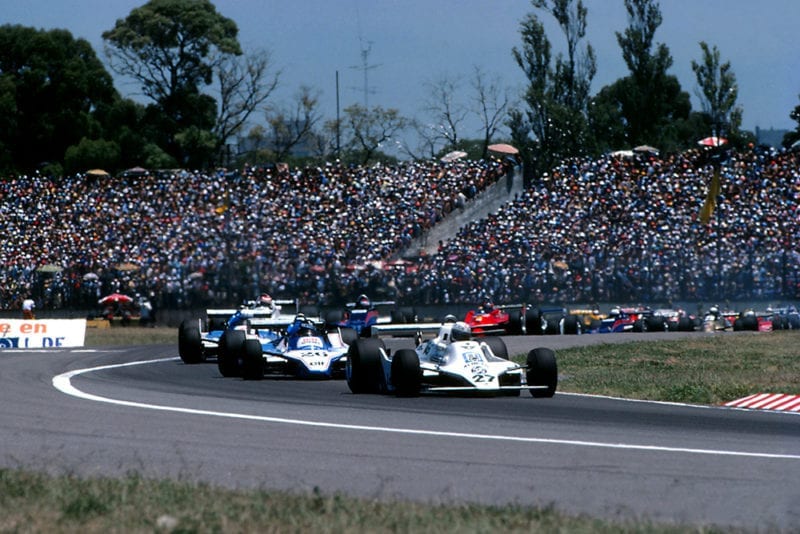
Jones converted pole into an early lead
© Motorsport Images
From his advantageous position at the head of the one-by-one grid, Alan Jones was away into the lead with a copybook start when the lights blinked green. The whole field got through the fast right/left kink after the start without drama, and streamed away towards the far end of the circuit, with Piquet lining his Brabham up for second place and Pironi’s Ligier falling away behind Andretti’s Lotus. Into the infield loops and back down into the hairpin before the pits it was Jones all the way, that familiar white and green number 27, now with LEYLAND added to its Saudi Arabian markings, passing in front of the grandstands with a commanding lead. In second place was Piquet in the blue and white Brabham, leading Laffite (Ligier), Andretti (Lotus), Reutemann (Williams), Pironi (Ligier), Scheckter (Ferrari), Prost (McLaren), Villeneuve (Ferrari), after running wide onto the grass during the opening lap, Rosberg (Fittipaldi), Mass (Arrows), Regazzoni (Ensign), de Angelis Lotus), after being punted by Patrese, Zunino (Brabham), Watson (McLaren), Giacomelli (Alfa Romeo), Depaifter (Alfa Romeo), Fittipaldi (Fittipaldi), Patrese (Arrows), after recovering from hitting de Angelis, and Surer (ATS), who headed for the pits. Jarier limped in to retire with frontal damage after stuffing his Tyrrell into the rear end of Watson’s McLaren, cracking that car’s gearbox oil cooler, which led to the inevitable retirement of the M29B after a further five laps as all the oil ran out, unbeknown to the driver.
On the second lap Pironi’s run came to an abrupt end when his Ligier’s Cosworth engine expired, while a lap later Arnoux’s Renault lost the right front wheel under braking for the pits hairpin. While the wheel bounded away into the distance the three-wheeled Renault pirouetted at high speed and stopped without hitting anything. Almost before the dust had settled the other Renault was crawling into the pits to retire with gearbox failure. It was a bad day for the French cars, whether they were blue or yellow.
Already the track was becoming desperately slippery. Laffite nipped past Piquet, to take second place, on lap 6, but the young Brazilian forced his way in front again almost immediately, and the Frenchman had another go on lap 9. Reutemann was hanging on in fourth place and got past Piquet on the return straight, only to find himself badly placed for the right-hander that followed, with the very determined Brabham driver “sitting it out” with him wheel-to-wheel into the braking area. The result was that Piquet scrabbled round the corner and Reutemann went up the escape road and spun on the grass, filling his radiator intake with earth and grass. Another lap had the temperature gauges rising rapidly so the Argentinian shot into the pits to have the debris cleared away, but the engine had already overheated and mid-way round lap 13 the engine failed and a dejected Reutemann climbed out when the car stopped. While this was happening Alan Jones had got off line and onto the “marbles” on the infield section and though he spun he kept the engine running and carried on without losing the lead, but during his spin he had scooped up a plastic bag in the radiator intake. His engine was running with a higher pressure release valve on the water system than his team-mate, and though the temperature soared to 120°C before he made a pit stop to have the bag snatched away by a mechanic, no damage was done. Jones had tried to reach over the cockpit side to release the plastic which he could see, but as he said afterwards “That was daft; all I did was nearly have my arm blown off . . .” When he rocketed back into the race he was in fourth place, behind Villeneuve who had come up through the field after his first lap “off” and was in third place. Laffite was out in front of Piquet, but the gaps were still small and Jones could see his adversaries and felt convinced he could catch them. The broken up surface was so bad that lap times were down some eleven or twelve seconds on what they should have been, and it was significant that most drivers had made their fastest laps within the first five or six. The cars were slipping and sliding precariously on the “marbles” of torn up tarmac and it called for a very sensitive right foot on the throttle pedal and very few of the runners got away without a spin or a sideways slide at some time or another.
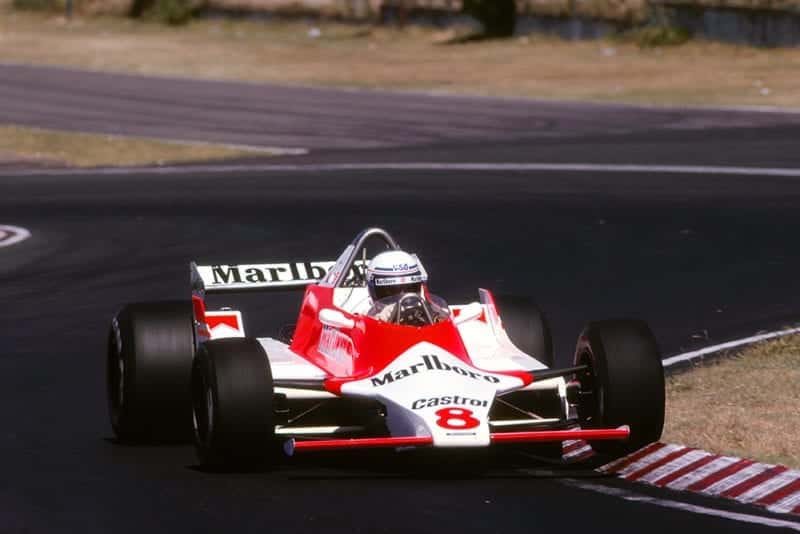
Alain Prost finished an impressive 6th on his McLaren debut
Motorsport Images
While this quartet argued over the lead, Scheckter’s Ferrari T5 was hanging on gamely in fifth place, clearly losing a fair amount of oil from a rear end leak. Then came Riccardo Patrese who’d pulled up extremely well after his early tangle with de Angelis, but on lap 14 his engine began to sound extremely rough, with a broken exhaust pipe. He nonetheless kept the pressure on the Ferrari until lap 28 when he retired out on the circuit with engine failure.
Earlier on Jochen Mass had a huge spin out on the back of the circuit which covered his Arrows with dust and dirt, but he plugged on gamely until lap 21 when he was forced to retire with gearbox trouble.
Both Lotus 81s had retired. Andretti had been running strongly with the leading bunch at the start, holding fourth place at the end of the opening lap. But he gradually dropped back down the field as his engine lost its edge and he made a pit stop on lap five to see if anything could be done. He resumed at a more gentle pace right down near the back of the field, but the problem was with the metering unit and with 20 laps completed he pulled in to retire for good.
By lap 23 the tussle at the front was getting pretty frenzied. Laffite managed to get a bit of daylight between his Ligier and Piquet’s pursuing Brabham thanks to some judicious squeezing through gaps when lapping backmarkers. Villeneuve now had Piquet right in his sights and clearly didn’t seem inclined towards messing around behind the Brabham for long and Jones was carefully examining the situation to see if there was a chance of jumping them both. Rosberg, running remarkably smoothly, was now up to sixth behind Scheckter, then came the consistent Daly, Giacommeli’s slipping and sliding Alfa and young Prost. McLaren’s number two had the mother-and-father of spins early in the race, bounding across the grass and tearing his M29B’s skirts off in the process. That didn’t daunt him in the least and the young Frenchman reckoned the car handled better than he would have expected after such an excursion.
Jones found a way ahead of Villeneuve for third place and then displaced Piquet next time round, the Brabham by now showing the first signs of overheating. On lap 30 Jones made it past Laffite and into the lead, the Ligier unfortunately responding by blowing up its engine on the next lap which took the pressure off Jones a little bit. That was just as well, because the Williams’s temperatures were still looking pretty precarious and, with that appalling track surface to negotiate, Jones could be forgiven for not wanting the added complication of a hard-charging Ligier right on his gearbox.
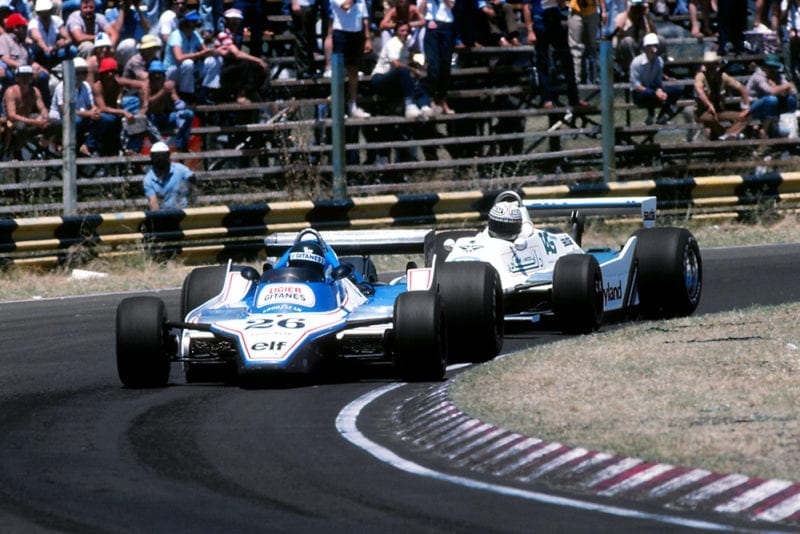
Jacques Laffite battled hard with Jones early on
Motorsport Images
But Jones was equally aware of the fact that Villeneuve was behind him. The “Cannuck” really started to pile on the pressure once there was only the Williams between him and the lead, and for a while it seemed that we might have a repetition of some of last year’s great scraps. Jones seemed fairly well in control of the situation although he was cutting things as closely as he could, and Villeneuve was having to run as near flat-out as he dared. Then, coming through the “esses” just before the last hairpin, Villeneuve’s T5 hurried straight on into the barriers on the outside of the circuit, failing to negotiate the right-hand section of the swerve. As the dust settled one could almost see the hole French-Canadian driver orientating himself and thinking “what was all that about?” He quickly composed himself, leapt from the wrecked Ferrari and ran across the circuit towards the pits where he expressed the opinion “something broke at the front”. A television replay all over the world showed an apparent steering failure on the Ferrari as it swooped into the comer, the scarlet flat-12 shooting off the road with the front wheels pointing in opposite directions.
From that point onwards, once he’d turned in a couple of quick laps to demoralise Piquet’s challenge, the race belonged to Jones. That is as long as his engine held together. But with Piquet Brabham similarly bothered by over-heating Jones was able to lengthen his lap times to over two minutes as he ran to a morale-boosting victory in the first GP of the season.
For Piquet, second place was a tremendous , justification of his fast-mushrooming talent, while. Rosberg only just scraped home third ahead of Daly. The Finn’s Fittipaldi was stuttering as it ran low on fuel and he dived for the pits with six laps to go to take on a few extra gallons. His mechanics slammed the “dump can” onto the fuel filler “counted to ten” and then pulled it off again, showering fuel over the pit lane as Rosberg hurtled straight back into the fray. Their timing was just about right, for Rosberg held off Daly by just under five seconds to the flag.
Fifth was Giacomelli after a steady run, the sole Italian “12” to finish after Scheckter’s Ferrari, in an easy third place, expired in a very terminal-looking cloud of oil smoke at the end of lap 45. Prost strove manfully to finish sixth while Zunino maintained a very circumspect pace to be the final classified finisher in seventh place.
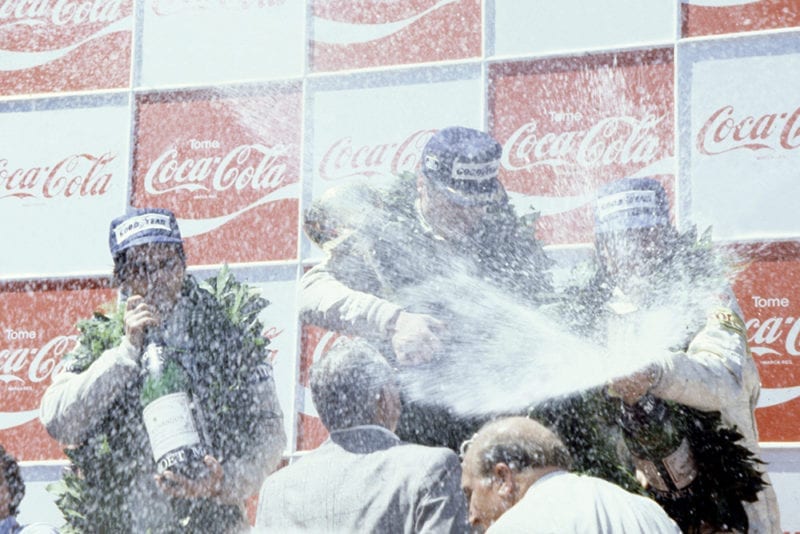
Jones, (centre) Piquet (right), and Rosberg (left) spray the first champagne of the season
© Motorsport Images
Regazzoni’s Ensign made three pit stops with a repeat of the throttle-sticking problem, an extra return spring being applied on each occasion; he was still running at the end, as was Fittipaldi, but they were both too far behind to be classtfied officially. Patrick Depailler looked as though he might last through to the finish only for his Alfa’s engine to give out with seven laps to go. “I started the day with some apprehension” smiled Depailler weakly after the race, “by the time I retired I was almost enjoying it again”.
There were some unpleasant moments at the post-race scrutineering when it looked as though the winning Williams and the second-place Brabharn might be slightly under the minimum weight limit. But there was some doubt about the scales’ accuracy and, apart from Ken Tyrrell getting very heated, the whole matter quickly evaporated. The Williams team doesn’t need to cheat to be successful. As for Jones, he was smiling brightly. When all the ifs and buts were laid at rest, he’d done the job. He’d negotiated the ruts, survived the spins and lasted the race.
A.H. / D.S.J.
